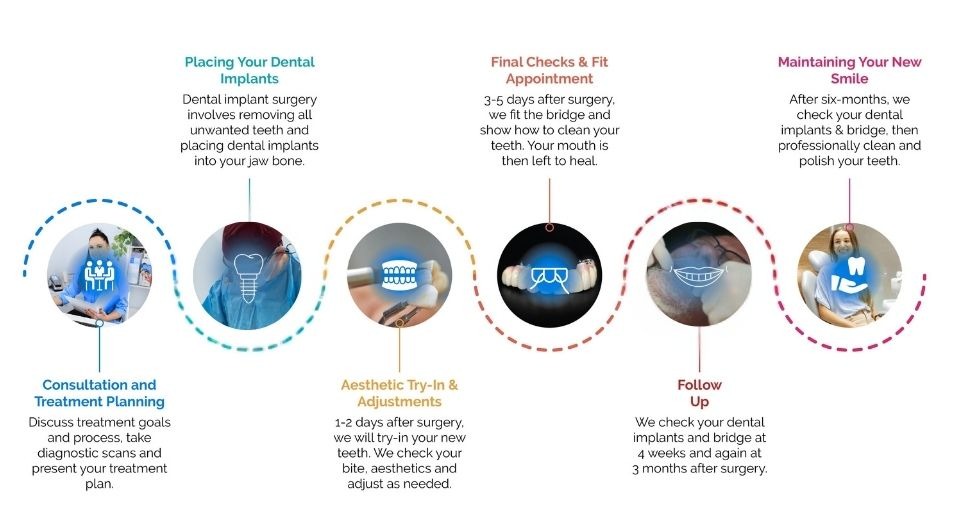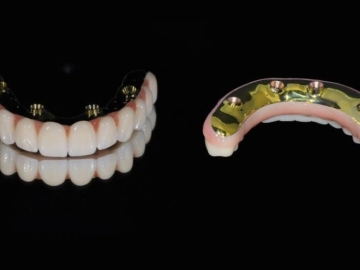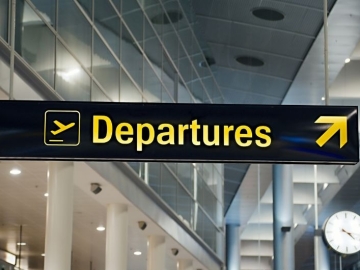
Posted on: 16 October, 2025
A new set of teeth in just 3–5 days, All-on-4® makes it possible.
5 minute read
If you're looking to replace missing or failing teeth or uncomfortable dentures, All-on-4® dental implants is one long-term solution to consider. All-on-4® teeth are designed to look and function just like the real thing – they’re even cleaned just like natural teeth, and the treatment process can be completed in considerably little time – but it’s worth understanding what you're committing to.
This guide breaks down the treatment process for All-on-4® dental implants, from your initial consultation with your dentist to your final bridge fitting and follow-up care. Learn more about what’s involved at each step or contact our team at Mount Lawley to book a consult and see if it’s right for you.

Like any dental procedure, the All-on-4® process starts with a discussion, medical history assessment and examination of your mouth. They will make sure you understand what the treatment involves, examine your mouth and jaws, and create your personal treatment plan.
Your dentist will listen to your concerns and goals from teeth replacement and discuss whether All-on-4® could be the right choice for you. They will help you to set realistic expectations for your new teeth and discuss the pros and cons of All-on-4® implants along with the alternative treatment options such as conventional dental implants or dentures or a combination of both.
Your dentist will examine your mouth and jaws to determine whether there is enough bone to support the implants and whether there are other problems, such as gum disease, that will need to be treated first. Dental implants need a strong and healthy jawbone to support new teeth, so if your jawbone isn’t strong enough, treatment may still be possible using longer implants or following a bone grafting procedure.
This assessment will involve taking a 3D CBCT scan of your jaw, which your dentist will also use to locate sinuses and nerves and plan the placement of your implants. If you’ve already had these scans in the past 6 months, your dentist can use these instead, saving you the expense of another one.
Your dentist will then give you a detailed treatment plan including the schedule and costs involved in treatment, ongoing maintenance and repairs as needed. If you decide to go ahead with All-on-4® implants, the clinic’s treatment coordinator will arrange your schedule of appointments. This will include meeting with our lab technician to choose the shape and shade of your new teeth and your surgery date.
To schedule your initial consultation with our All-on-4® dentist in Perth, call us now on (08) 9227 8777.

All-on-4® implants are placed in a single appointment, which usually takes around 2–3 hours per arch.
Your dentist will carefully place four or more implants in your jaw and stitch the gum closed. They will then take a digital impression of the implants in your mouth that will be used to custom make your bridge and place temporary healing caps over the top of each implants.
If you have some teeth remaining that need to be removed, this is done before implants are placed. If you need another procedure such as bone grafting, your dentist may perform these on the same day. At times, your dentist will need to place additional or longer implants to ensure good stability however, this decision is often made during the time of your surgery.
Local anaesthetic is used as standard during All-on-4® surgery to numb pain in the parts of your mouth being treated. If you have dental anxiety or you’re having a more complex procedure, your dentist may recommend other sedation options, such as IV sedation and general anaesthetic. Surgery takes place at the dental clinic under local or intravenous sedation, or if you choose to have surgery under general anaesthesia, you will be treated in hospital.
Once your procedure is complete, you’ll be accompanied home by your designated carer and you’ll be without teeth until your final fit appointment (1-3 days after surgery).
Before your dentist can attach your permanent All-on-4® teeth, they'll call you in after 1–3 days to try on a wax-up model prepared by our dental technician. This model has been designed using the digital impressions taken of your mouth during surgery. As you’ll be tender after your surgery, we typically ask that you take paracetamol prior to this appointment to help reduce any discomfort. During your appointment, the technician will check your bite and comfort and note down any adjustments that may be needed for the final teeth.
Within 3–5 days of your surgery, your final bridge will be ready. Your dentist will attach it to your implants, check its fit and appearance, and give you instructions on caring for your new teeth, your health and diet during your recovery period. They will also provide you with a water flosser to clean under your bridge and advise when to begin using it.
If you grind your teeth, your dentist may also prescribe a custom-made bite splint, similar to a mouthguard, to protect your bridge from any grinding damage at night.
Most dentists who provide All-on-4® treatment place a temporary acrylic bridge as your initial bridge while your mouth and jaw are healing from All-on-4® surgery. This bridge is designed to be replaced after 3–6 months when your jaws heal, after which they need to be replaced with a more permanent bridge made of either titanium-acrylic, zirconia or porcelain.
At Mount Lawley Dental, we place a durable titanium-reinforced acrylic bridge as your first set of All-on-4® teeth. This high-impact acrylic bridge can last 2–5 years or longer with proper care, reducing or avoiding the need for a replacement bridge within the first year of having surgery. A reinforced titanium-acrylic bridge allows for a more passive fit and will aid faster healing of implants.
Aftercare is an important part of the All-on-4® journey. Your dentist will schedule follow-up visits to remove any remaining stitches, check that your mouth and jaw are healing and answer any questions you have about your dental implants.
At Mount Lawley Dental, we schedule follow-up visits 4 weeks, 3 months and 6 months after your procedure. Your dentist will make any adjustments required to your bite on your fitting day and will be able to adjust for any speech issues either before or during your follow-up visit. Your dentist will take pictures of your new teeth during one of those visits so you can compare your before and after photos and see the results.
It’s also important that you keep up with your regular dental check-ups once or twice a year so your dentist can check the condition of your All-on-4® teeth and your oral health and provide any treatments needed. It’s also recommended to have a new set of x-rays and bone scans every 1 to 2 years so your dentist can monitor the condition of your implants and jawbone.
You should take it easy after your All-on-4® surgery and have someone drive you home and stay with you for 24 hours, especially if you had sedation. It can take some time to adjust to eating and speaking with your new teeth, especially if you’ve been without full teeth for a long time and haven’t worn prosthetic teeth before.
Like any prosthetic body part, dental implants will take some getting used to and will start to feel more natural as you heal. Most people feel comfortable with their All-on-4® teeth within a few weeks, especially when following their dentist’s recommendations about what to eat and how to avoid complications.
It’s normal to feel some pain after All-on-4® surgery once the anaesthesia or sedatives wear off. Over-the-counter pain medication such as paracetamol should minimise discomfort. Pain and swelling should reduce in a few days. If your pain continues for longer, or you have other unexpected symptoms, contact your dentist.
In the first few days before your permanent teeth are fitted, you should consume only a liquid diet, avoiding very hot or cold liquids and not touching the implant site directly. Once your bridge is attached, you should follow a soft diet for 7 days (or until your dentist thinks you’re ready to introduce harder foods) and avoid hard, crunchy or sticky foods for 8–12 weeks.
You can brush your teeth twice daily like natural teeth to reduce bacteria and odours in your mouth. Two weeks after surgery you can begin using the water flosser that your dentist gave you, this will help to remove food debris from under your bridge. Any time after your surgery, we strongly recommend you avoid smoking to lower the risk of implant failure. Your dentist will give you cleaning instructions at each review appointment.
All-on-4® treatment at Mount Lawley Dental starts from $21,000 per arch or $40,000 for both arches, depending on the number and type of implants and any additional services you need. We partner with finance providers to help make treatment more accessible.
This price includes:
Your All-on-4® implants and titanium bar will be covered by a 5-year warranty and your acrylic bridge by a 2-year warranty.
Other costs not included in the treatment price are:
Once they have successfully bonded with the bone, titanium implants can usually last a lifetime when you maintain good oral health and avoid risk factors such as smoking.* However, your teeth may need to be repaired, remodelled or replaced after several years. Your options will include:
* Malo P, de Araújo Nobre M, Lopes A, Moss SM, Molina GJ. A longitudinal study of the survival of All-on-4® implants in the mandible with up to 10 years of follow-up. J Am Dent Assoc 2011;142:310-204
If you need some support with your All-on-4® treatment costs, we’ve partnered with trusted finance providers to offer some options, including payment plans, dental loans and early super access subject to provider approval and individual eligibility. Contact our team to find out more.
If you’re ready to take the first step on your All-on-4® journey, get in touch with Mount Lawley Dental on (08) 9227 8777 to book a consultation with our dentists or book online. We welcome patients from all parts of North Perth, including Highgate and Inglewood.
Results vary between individuals, not everyone is suitable for dental implant treatment. Any surgical or invasive procedure carries risks. Before proceeding, you should seek a second opinion from an appropriately qualified health practitioner.

How Long Do All-On-4® Dental Implants Last in Australia

Overseas All-on-4® Treatment vs Australia: Is It Safe?

All-on-4® Recovery Diet: What to Eat After Surgery